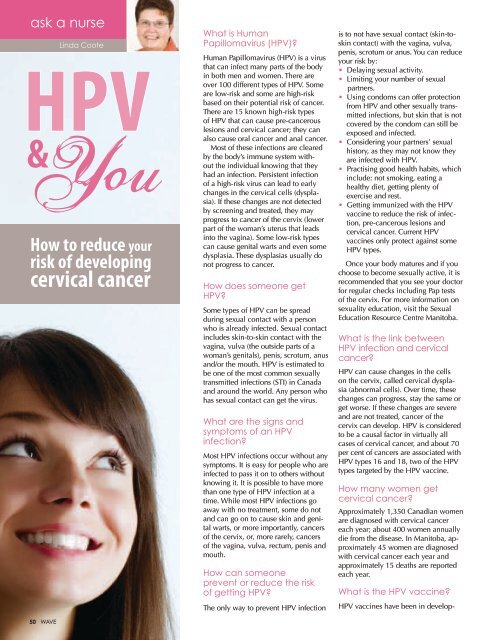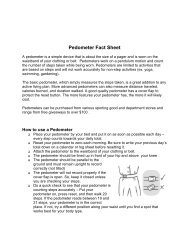ask a nurseLinda CooteHPV& YouHow to reduce yourrisk of developingcervical cancer50 WAVEWhat is HumanPapillomavirus (HPV)?Human Papillomavirus (HPV) is a virusthat can infect many parts of the bodyin both men and women. There areover 100 different types of HPV. Someare low-risk and some are high-riskbased on their potential risk of cancer.There are 15 known high-risk typesof HPV that can cause pre-cancerouslesions and cervical cancer; they canalso cause oral cancer and anal cancer.Most of these infections are clearedby the body’s immune system withoutthe individual knowing that theyhad an infection. Persistent infectionof a high-risk virus can lead to earlychanges in the cervical cells (dysplasia).If these changes are not detectedby screening and treated, they mayprogress to cancer of the cervix (lowerpart of the woman’s uterus that leadsinto the vagina). Some low-risk typescan cause genital warts and even somedysplasia. These dysplasias usually donot progress to cancer.How does someone getHPV?Some types of HPV can be spreadduring sexual contact with a personwho is already infected. Sexual contactincludes skin-to-skin contact with thevagina, vulva (the outside parts of awoman’s genitals), penis, scrotum, anusand/or the mouth. HPV is estimated tobe one of the most common sexuallytransmitted infections (STI) in Canadaand around the world. Any person whohas sexual contact can get the virus.What are the signs andsymptoms of an HPVinfection?Most HPV infections occur without anysymptoms. It is easy for people who areinfected to pass it on to others withoutknowing it. It is possible to have morethan one type of HPV infection at atime. While most HPV infections goaway with no treatment, some do notand can go on to cause skin and genitalwarts, or more importantly, cancersof the cervix, or, more rarely, cancersof the vagina, vulva, rectum, penis andmouth.How can someoneprevent or reduce the riskof getting HPV?The only way to prevent HPV infectionis to not have sexual contact (skin-toskincontact) with the vagina, vulva,penis, scrotum or anus. You can reduceyour risk by:• Delaying sexual activity.• Limiting your number of sexualpartners.• Using condoms can offer protectionfrom HPV and other sexually transmittedinfections, but skin that is notcovered by the condom can still beexposed and infected.• Considering your partners’ sexualhistory, as they may not know theyare infected with HPV.• Practising good health habits, whichinclude: not smoking, eating ahealthy diet, getting plenty ofexercise and rest.• Getting immunized with the HPVvaccine to reduce the risk of infection,pre-cancerous lesions andcervical cancer. Current HPVvaccines only protect against someHPV types.Once your body matures and if youchoose to become sexually active, it isrecommended that you see your doctorfor regular checks including Pap testsof the cervix. For more information onsexuality education, visit the SexualEducation Resource Centre Manitoba.What is the link betweenHPV infection and cervicalcancer?HPV can cause changes in the cellson the cervix, called cervical dysplasia(abnormal cells). Over time, thesechanges can progress, stay the same orget worse. If these changes are severeand are not treated, cancer of thecervix can develop. HPV is consideredto be a causal factor in virtually allcases of cervical cancer, and about 70per cent of cancers are associated withHPV types 16 and 18, two of the HPVtypes targeted by the HPV vaccine.How many women getcervical cancer?Approximately 1,350 Canadian womenare diagnosed with cervical cancereach year; about 400 women annuallydie from the disease. In Manitoba, approximately45 women are diagnosedwith cervical cancer each year andapproximately 15 deaths are reportedeach year.What is the HPV vaccine?HPV vaccines have been in develop-
ment for many years. At this time, thereis only one HPV vaccine that has beenapproved for use by <strong>Health</strong> Canada. Whenthis vaccine is given before being exposedto HPV, it is highly effective in preventinginfection from two of the HPV high-risktypes. These high-risk types (Type 16 andType 18) account for about 70 per cent ofcervical cancers. The vaccine also protectsagainst two low-risk types (Type 6 and Type11) of HPV, which cause about 90 per centof all genital warts.The vaccine is given in three separatedoses (needles/shots) in the upper arm overa six-month period. Clinical trials haveshown that the vaccine is effective for atleast five years. It is not known at this timewhether a booster dose will be needed.Why is the HPV vaccine recommendedfor women?By preventing HPV infections that cancause pre-cancerous changes in the cervix,it is expected that the vaccine will reducethe rate of abnormal pap smears and therate of cancer of the cervix. Currently, thevaccine is only approved for use in womenby <strong>Health</strong> Canada. Therefore, unlike mostother vaccines, the goal of the program isto reduce the risk for women who are vaccinated,rather than to reduce the spreadof HPV in the whole population. Womenwho receive the vaccine should continue tobe screened regularly with a Pap test. Thisis because the vaccine does not protectagainst all types of HPV that can causecancer and because the vaccine has notbeen studied long enough to show howmany cancers will be prevented.For more information on screening,women should talk to their health-careprovider or contact the Manitoba CervicalCancer Screening Program.Who should receive thevaccine?The National Advisory Committee onImmunization (NACI) recommends the vaccinefor females between the age of nineand 26 years. The vaccine is thought to bemost effective before the onset of sexualactivity; however, females between theages of nine and 26 years can still receivethe vaccine even if they have already beensexually active. Women who are alreadysexually active may be infected with anHPV type contained in the vaccine, butthey can still benefit from protectionagainst the other HPV types the vaccineprotects against. Females who have hadprevious Pap test abnormalities, includingcervical cancer, or have had genitalwarts or known HPV infection, could stillbenefit from the vaccine. These womenmay not have had infection with the HPVtypes included in the vaccine and are veryunlikely to have been infected with all fourHPV types contained therein. It is thereforerecommended by NACI that these womenreceive the vaccine. However, they shouldbe advised that there is no data to suggestthat the vaccine will have any therapeuticeffect on existing cervical lesions. The vaccinedoes not treat existing HPV infections,genital warts or cervical abnormalities.Who will be offered the vaccinein Manitoba?Manitoba <strong>Health</strong> and <strong>Health</strong>y Living hasintroduced a voluntary, publicly fundedvaccine program for Grade 6 girls only.The program will be delivered by publichealth nurses. Before any female receivesthe immunization, information about HPVinfections, the vaccine, and a consent formwill be provided to parents and/or legalguardians.Who should not receive thevaccine?Females under the age of nine or over theage of 26. The safety and effectiveness ofthe vaccine has not been evaluated in childrenyounger than nine years. In addition,the vaccine should not be given to:• Pregnant women.• Anyone who is allergic to any of theingredients listed in the vaccinepackage information.• Individuals who develop symptoms ofhypersensitivity after receiving a doseof the vaccine.Is the HPV vaccine safe?Yes, the vaccine is considered safe, butas with all vaccines, adverse events mayoccur, including rare, life-threatening reactions.<strong>Health</strong> Canada has done a scientificreview of the quality, safety and efficacy ofthe vaccine and has approved it for use.What are the possibleside-effects?The most commonly reported side-effectsof this vaccine are: pain, swelling, itchingand redness at the injection site, fever,nausea, dizziness, headache and vomiting.Fainting has been reported. Fainting canoccur after vaccination, most commonlyamong adolescents and young adults.As with any vaccine or drug, severe,allergic, life-threatening (anaphylactic)reactions may occur, with symptoms suchas: difficulty breathing, wheezing (bronchospasm)and hives or rash. It is a routinepublic health practice to observe individualswho have received a vaccine for at least15 minutes following immunization. Aswith other vaccines, side-effects that havebeen observed after vaccination include:swollen glands (neck, armpit or groin).Guillain-Barré syndrome, a rare form ofparalysis that is usually temporary, hasbeen reported, but a confirmed link to thevaccine has not been established. For additionalinformation on other rarely reportedside-effects, please consult your publichealth nurse or doctor.Linda Coote is a registered nurse and amanager with the <strong>Winnipeg</strong> <strong>Health</strong> Region’s<strong>Health</strong> Links - Info Santé help line.FYIYou can access healthinformation from aregistered nurse 24 hoursa day, seven days aweek by calling <strong>Health</strong>Links - Info Santé.Call 788-8200 or toll-free1-888-315-9257.For more information on the program, please visit www.cancercare.mb.caThere are many viewpoints and perspectives on the HPV vaccine andHPV-related matters. The following links provide additional information,covering a range of facts and opinions. These links are not exhaustive andthe opinions expressed are not necessarily the opinions of Manitoba <strong>Health</strong>and <strong>Health</strong>y Living.Public <strong>Health</strong> Agency of Canada: www.publichealth.gc.ca (Search: HPV)Sexual Education Resource Centre Manitoba: www.serc.mb.ca/ (Search: HPV)<strong>Fall</strong> <strong>2009</strong> 51













